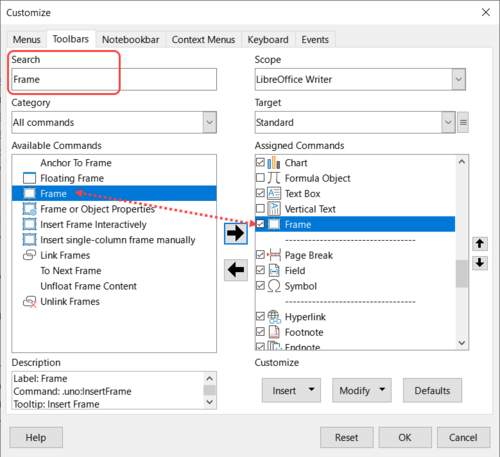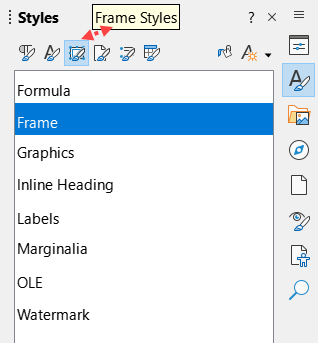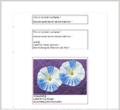Frame in Writer
TDF LibreOffice Document Liberation Project Community Blogs Weblate Nextcloud Redmine Ask LibreOffice Donate
Foreword
The video shows how to create and edit "Frames in Writer - LibreOffice" and links to this page here, which provides further information and details.
The basis of this description is the Online help: Inserting, Editing and Linking Frames
Link to the Video
Link to the Video (in German [DE]):
Rahmen in Writer (Frames in Writer)
Inserting, editing and linking Frames
Frames (in German: Rahmen) are independent objects.
A Frame is a "container" for text and graphics that you can position anywhere on the page.
To insert a Frame
Select the text to be included in the Frame.
Select ▸ ▸ and click .
Or choose ▸ ▸ from the menu to create an empty frame.
Customize the "Standard" toolbar
If you need frames more often, you can also customize the "Standard" toolbar, for example, by integrating the "Frame" icon there.
Customize the toolbar in the ▸ menu or rightclick the Standard toolbar and choose .
The "Customize" dialog appears.
Enter Frame under "Search".
You will now see the available commands for Frames.
You can assign the command "Frame" to the "Assigned commands" using the arrow in the middle.

To edit a Frame
Edit content
To edit the content of a Frame, click in the unselected Frame and make the desired changes.
The text in the Frame is treated like normal text on a page.
So the best way is to format the text with styles (paragraph and character styles).
Edit Frame Style
Frame Styles can be found in the sidebar under Format Styles.

With Frame Styles you can format text and graphic Frames.
Frames have the Frame Style "Frame" assigned to them when they are inserted.
The entries contained in the Frame Style "Frame" are the basis for new Frames to be inserted.
If you frequently need a particular Frame, you should make all the necessary settings in the Frame Style "Frame".
Rightclick on the Frame Style "Frame" and choose .
Then select the following tabs in the dialog "Frame Style: Frame" to make your settings:
-
"General" Tab
-
"Type" Tab
-
"Options" Tab
-
"Wrap" Tab
-
"Area" Tab
-
"Transparency" Tab
-
"Borders" Tab
-
"Columns" Tab
-
"Macro" Tab
Tab - General
Here you make specifications for the Frame style Name.
Tab - Type
Here you make specifications for size, position, anchoring and Protect.
- Size: Width and Height
- Protect: Contents, Position, Size
- Position: Horizontal and Vertical
- Anchor: To page, To paragraph, To character and As character.
Tab - Options
Here you can make settings for Accessibility, Sequenz, Content Alignment and Properties.
Tab - Wrap
Here you make entries for Settings (wrap), Spacing and Options.
Tab - Area
You can choose between None, Color, Gradient, Image, Pattern and Hatch.
Tab - Transparency
Procedure for the Area Transparency Mode.
Tab - Borders
Here you have the options for Line Arrangement, Line, Padding and Shadow Style.
Tab - Columns
Settings for number of Columns, Width and Spacing and Separator Line.
Tab - Macro
Here you can assign a macro.
Save document as document template with modified Frame Style "Frame"
If you have changed the Frame Style "Frame" in the empty document for your purposes, you should save the document as a document template.
Change inserted Frames
If you still want to make changes to the inserted Frame, right-click on the Frame and select from the Context menu.
The Frame Style remains unaffected by these settings.
However, the better way is to create one or more Frame Styles for your own purposes.
Change the settings you need in each of the additional Frame Style.
However, an inserted frame will always be associated to the Frame Style "Frame" first.
If you have inserted a Frame and want to assign another Frame Style, select this Frame and double-click on the desired Frame Style.
The relation Frame Style to Properties Frame
A frame that is newly inserted basically has the "Frame" style and takes on the properties defined there.
There are now two ways to change an inserted frame:
- You create your own Frame Styles and assign them to the desired frames.
- Rightclick on the frame and select Properties from the context menu and modify it. This means that the frame now has its own inner frame style, so to speak. However, these properties will only remain until an existing Frame Style is assigned to the frame.
Caption the Frame
In text documents, you can add sequentially numbered Captions to Frames.
You can define and edit the Caption text as well as the number circles per category for the different Captions.
For example, for the category, you could enter "Text Frames".
For Frames with pictures, you could enter "Graphic", for example.
To create a Caption, proceed as follows:
Rightclick on the Frame you want to add a Caption to.
Select from the Context menu.
Select the desired options and then click .
Caption s are formatted with the Paragraph Style that corresponds to the name of their category.
For example, if you insert a Caption for a "Table", the paragraph style "Table" is used for the corresponding Caption text.
Anchor and position Frames
An object, for example a Frame or a Picture, is positioned within a document using anchors attached to other elements (page, paragraph, character).
A Frame always has an anchor and thus a reference point.
The reference point (anchor) of the Frame could be the page, a paragraph or even a character.
An anchor moves with the element it is attached to while the document is being edited.
An object maintains its position relative to the reference point determined by its anchor, so the object moves relative to it whenever the reference point moves or changes.
The following anchors are available:
See also Anchoring objects.
To Paragraph
Anchors the selected Frame in the current paragraph.
As Character
Anchors the selected Frame as a character in the current text.
If the height of the selected object is greater than the current font size, the height of the line containing the object is increased.
To centre a graphic on an HTML page, insert the graphic, anchor it "As Character" and then centre the paragraph.
To Character
Anchors the selected Frame to a character in the paragraph to which the anchor is attached.
To Page
Anchors the selected item to the current page.
Select the frame.
Choose ▸ ▸ from the menu.
In the "Frame" dialog in the "Position and Size" tab, you can anchor the frame to the page, for example.
To exclude text from printing
Any Writer Frame can be set so that it is visible on the screen but not in the printout.
Select the Frame (the eight selection handles will be visible).
Select ▸ ▸ the Options tab.
In the Properties area, uncheck Print and click .
To link Frames

You can link Writer Frames so that their text content automatically flows from one Frame to the next.
Click the edge of the frame you want to link to select it.
Eight selection handles appear on the edges of the Frame.
In the "Frame" toolbar, click on the "Link Frames" icon. ![]()
The cursor now consists of three connected circles that symbolically represent a chain. ![]()
Click on the Frame to be linked to the first Frame.
Linking Frames is only possible under the following conditions:
- The target Frame is empty.
- The target Frame is not linked to another Frame.
- The source and target Frames are in the same area. For example, it is not possible to link a Header Frame with a Footer Frame.
- The source Frame is not yet linked to a successor Frame.
- Source and target Frames are not nested.
- The Frames do not have a Caption.
When you select a linked Frame, a connecting line appears between the linked Frames.
Unlinking Frames
To unlink two Frames.
Only the link from the selected Frame to the target Frame can be unlinked at a time.
Click on the "Unlink Frames" icon in the "Frames" toolbar. ![]()
Example Frames
-
Examples Frame
Further Informations
Files on the subject
The following files are in German language:
Zum Video.odt
Beispiele Textrahmen Grafikrahmen.odt
Documentation / Manuals
Here you will find the Documentation / Manuals:
Any questions?
For questions on this topic go to:
Get Involved
Join us today and help us to make it even better!
Donate
LibreOffice is Free Software and is made available free of charge.
Your donation, which is purely optional, supports our worldwide community.
If you like the software, please consider a Donation.









